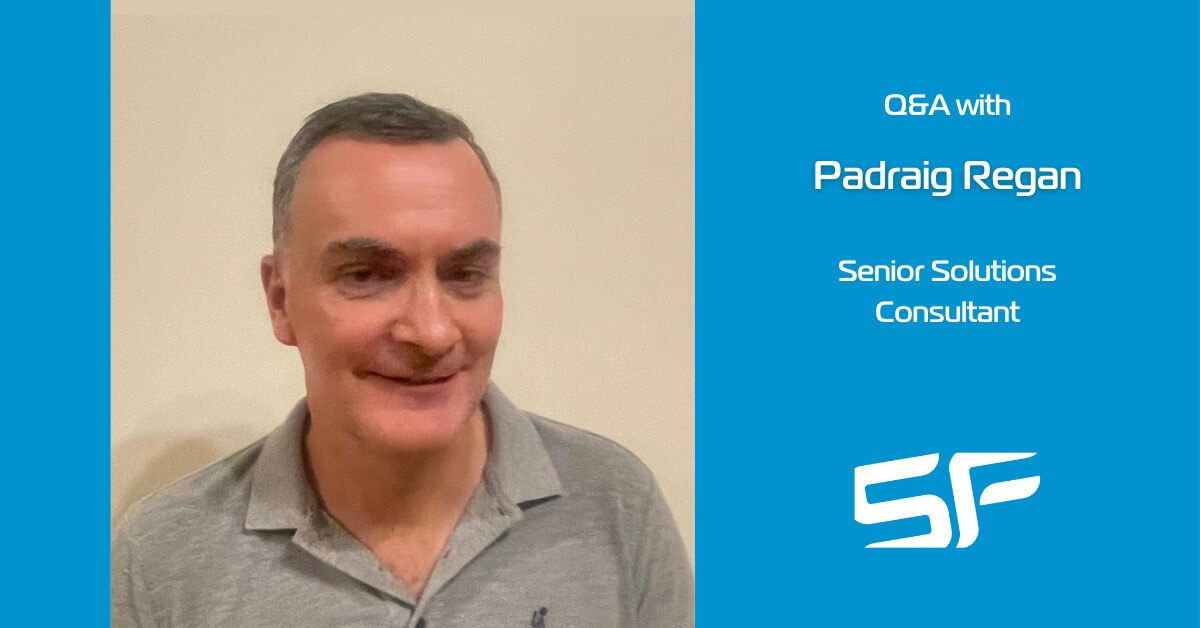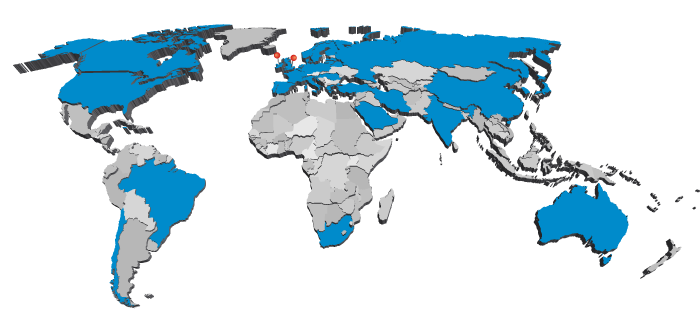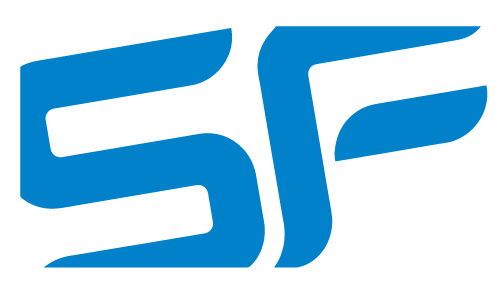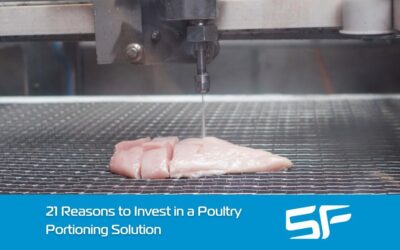Q&A With Solutions Consultant Engineer Padraig Regan

Padraig Regan is one of SF Engineering’s longest-serving employees, having joined the company almost 30 years ago. He has witnessed SF Engineering’s evolution and growth, and he has travelled the world designing and delivering production line solutions to food processors.
Padraig has also adapted to the various opportunities and obstacles he has encountered along the way, from the introduction of email to changing business relationships to continuing to work at the top of his profession with a serious health condition. His story is as unique as it is inspirational.
Question: What is your role and what are your responsibilities in SF Engineering?
Padraig: “I create concept drawings for production lines in the food processing industry. I engage with customers to get that concept drawing defined to suit their needs, allowing the sales team to submit a quotation for the project. If we are successful in receiving an order for the project, I then hand it over to project managers and the production team.
Question: How did you get into this industry? What is your background?
Padraig: “I started off working for Powerscreen creating drawings for conveyors for quarrying equipment and, later, as a production manager for CPV, a business unit in the same company that manufactured stainless steel pressure vessels. I then got married and wanted to move towards home. That was in 1994. Seamus Farrell (SF Engineering founder and Managing Director) was looking for an engineer who could draw, who understood conveyor design, and who understood working with sheet metal and stainless steel. I had experience in all these areas.
“Up until then, the company was contracting out the design work but there were problems with some of the designs. One of my first projects was retrofitting parts to a conveyor at a fish processing plant that had issues with the belt specification and motor location. The work to resolve the issues had to take place during a factory shutdown and the only time available was at Christmas.
“On the first day of their (and SF’s) shutdown for Christmas, we were up there modifying the conveyor. This was an indication of SF Engineering’s commitment to customers, as is still the case, that SF will go to any lengths to deliver a successful project to its customers.
“Those early days included making the case to Seamus that we should buy a computer to do the drawings. I was also there when we got our first email in around 1996. Before then we used to send drawings up and down by mail and it would take weeks to get drawings approved. Emails were revolutionary at the time because we could get drawings approved on the same day.
“At that time, Seamus was in sales, and my role was going to the customer to measure up, do the design drawings, oversee them through production, purchase the components, and look after the installation. So, you were involved in the whole process the whole way through. As it was a small business, I was involved in all aspects of the operation. It was a great place to develop my knowledge of the food processing industry and dealing with customers.
“The business grew over time, and I started to move more and more towards sales. Initially, it was mainly in Ireland, but then our business with Ishida grew and I ended up doing a lot of the Ishida account managing. That meant travelling the world with SF Engineering, dealing with projects all over Europe and in places as far away as Russia, Chile, and Saudi Arabia. I really enjoyed these work experiences and the interactions with the local people in these locations.
“That brings me up to 2018 when I got diagnosed with Multiple Sclerosis. One of the first things I noticed was my walking. They call it foot drop – my foot would just clip the floor as I was walking. The first couple of times I noticed it was running up steps out of a train station in Russia and my foot would clip the step and I would kind of trip and think that was a bit careless of me. But that was the start of my MS journey.
“Over time, the walking got worse to the point I was unable to walk. I ended up moving to work in the office. SF Engineering provided a significant amount of support for me with access and other arrangements. In terms of the day-to-day, a salesperson would handle the customer visit element and I would do the design work back in the office, but it was a much less interactive process for me than when I was on the road myself.
“Then Covid came along, and nobody could leave the office. Everybody went onto online meetings.
“Online meetings were revolutionary for me, as I am now back to the way I was before. Again, the support from SF Engineering was substantial as they facilitated my transition to 100 percent working from home.
“Now I can talk to people on a Teams call wherever they happen to be. I can talk them through the drawings I’ve created, or create with them, the same as I used to when I was sitting in their office somewhere in Russia or wherever – it’s just now I do it working from home.
“In fact, you have a better array of tools now because you have full access to the server. You can pick up the drawings, pull them into a layout, and show photographs of projects we have done before. So, it’s actually better now and along with that, you don’t need to travel for three days for a two-hour meeting. Now you can have a two-hour meeting without leaving the desk, so Teams has been revolutionary for me in terms of access to customers. You still need salespeople to build customer relationships, but once you get the enquiries, they can be managed quite successfully remotely.
“So, I am back doing what I was doing but without the travel.”
Question: How have you seen the company change?
Padraig: “I’ve seen it grow from everything being manual to all digital now. You used to be able to draw something on a bit of paper and it would be made. Now, nothing goes to be manufactured unless there is a 3D drawing. Laser cutting, 3D drawings, computerisation, global shipping, working exclusively in the food industry – it’s a changed company.
“It’s a much larger company now too. When I started, there were about 12 people. Of those 12 people back in the early days, there are still four of us left, including Seamus, Mick, Gerry, and me. That isn’t bad I suppose – four have survived 30 years.
“Back in the early days, we supplied conveyors to the fish industry in Ireland and also carried out small stainless steel projects for the construction industry. SF then expanded into the fishing industry in Scotland as our first export sales. The big change and growth came when we diversified into projects in the meat industry, developing expertise in red meat and poultry processing solutions.
“Other changes are when we entered into a distribution agreement with Ishida where we would sell Ishida equipment in Ireland. This developed into a two-way relationship where we marketed their equipment in Ireland, and we supplied conveyors and ancillary equipment for their projects globally.
“The acquisition of Opal Engineering in the UK – that was a big change for us too. We then had projects from the two sites that needed to be managed and often built across both sites, depending on lead times and orders.
“Over the years the premises have become unrecognisable too. We have grown from three small workshops of 600m2 to 8,000m2 of modern manufacturing facilities with state-of-the-art equipment and over 150 people employed.
Question: How have you seen the food processing industry change?
Padraig: “Back in the early days, everything was very manual as labour was available and relatively cheap. Everything is now about automation and ergonomics. The current needs are around automation to reduce giveaway and improve yield on products while allowing people to be used where they can add the most value to the process. There has been a complete change of culture as people are now a very scarce and valuable resource.
“The business expectations have changed too. The quality that is expected, the service that is expected, the expectations of what they are getting are now so much more. And people are more knowledgeable of what is required now.”
Question: What gives you the most satisfaction from the job?
Padraig: “The most satisfying thing is when you draw a factory or line layout and you then bring that to real life, from start to finish. You can see it developing from lines on a page, through production in SF, installation on the customer’s site, and finally seeing it working in the factory. You get to see that complete thing that you dreamt up in your head becoming a reality.
“It’s a good buzz, especially when customers come back to say it’s exactly what they wanted, and the job worked out well.”
Question: What makes SF Engineering stand out from the competition?
Padraig: “Customer relationships. Everything is about relationships with customers and building on them. It’s not just about trying to sell them something all the time. It’s about supplying the right solution for their needs. SF has a wide range of knowledge gained across many years in the business and we have partnered with global brands. This allows us to supply turnkey solutions for a large range of applications.
“When you invest in a solution supplied by SF Engineering, you get the benefit of SF’s and our partners’ experience, making the process as easy as possible for you and ensuring the result meets your expectations.”







